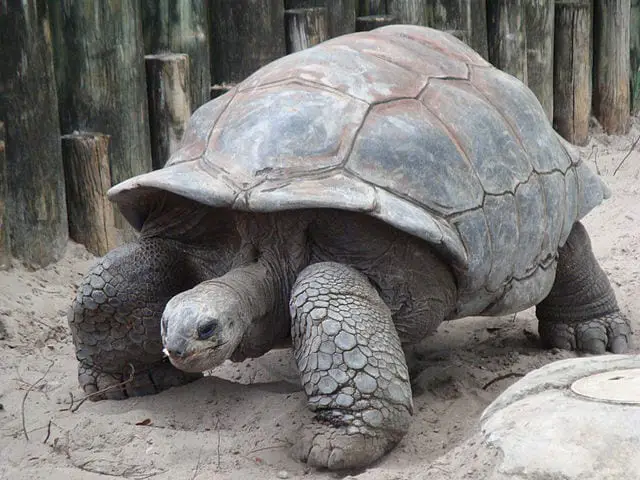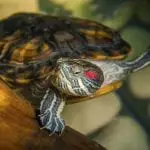All over the world, lots of animals are becoming endangered, and that includes turtles. In fact, the populations of turtles and tortoises have been dealing with illegal hunting because of the pet trade and to use them for food. Additionally, the major cause can be linked to their habitat loss and using these animals for traditional medicine. Here are the species that are vulnerable and are critically endangered and what you can know about them.
Giant Tortoise
Giant Tortoises are more commonly connected to two remote groups of tropical islands. First is the Galapagos Island in Ecuador, and the second is the Aldabra Atoll and the Fregate Island in Seychelles. These enormous turtles can grow as heavy as 919 pounds or 417 kg, and they can reach up to 4 feet and 3 inches long or 1.3 meters.
The Giant Tortoises have been historically studied to make their way into these isolated islands through ocean dispersal from the mainland. They traveled through being helped to float and to have the ability to float their heads up. Plus, these turtles are so well-equipped that they can survive for up to six months without having fresh water and food.
The reason why these turtles grow so big is their development of island gigantism, which occurs because of their adaptation to the extreme fluctuations in the environmental conditions on the island. These turtles are actually said to be one of the longest living animals in the world, and they can even live up to 100 years.
There are four known subspecies of this turtle: the Aldabra giant tortoise, Canary Islands giant tortoise, Galapagos giant tortoise, and Mascarenes giant tortoises.
- This Aldabra giant tortoise is a species that is vulnerable to extinction when in the wild. However, the home turf of these tortoises has been declared as a World Heritage Site and is now home to about 152,000 Aldabra giant tortoises, which is the largest population of these turtle species.
- The Canary Island giant tortoise has already been extinct, and only their remains have been found.
- The Galapagos giant tortoises are currently at their last 10 species, which were originally at 16 species. They first existed 2 to 3 million years ago.
- The Mascarenes giant tortoises were great evolutionary turtles that we’re able to adapt with many life challenges, and they were modified to have reduced scales, modified jaws, and 1 mm thick shells.
Green Turtle
The green turtle is one of the largest sea turtles and the only herbivore among the different species. Green turtles are named because of their greenish color of their fat and cartilage, not their shells. In the Eastern Pacific, green turtles that have darker shells are called black turtles by the local community.
The green turtle can be identified through these physical characteristics: paddle-like arms, dorsoventrally flattened body, and a beaked head at the end of a short neck. These adult turtles grow up to 1.5 meters or 5 feet long. Their average weight is about 68 to 190 kilograms, and their average carapace length is 31 to 44 inches or about 78 to 112 cm.
In the last few decades, the green turtle has moved from unrestricted exploitation to global protection, with individual countries providing them with additional protection, although there are still many threats that should be dealt with.
The green turtles are enlisted as endangered by the IUCN and the CITES, and they are protected against exploitation under regulations in many different countries. It is illegal to harm, kill, and collect these turtles, and they are also in danger because of various human activities. In some countries, people hunt for their eggs, young ones, and matured turtles to use their parts for food. Furthermore, pollution can also directly harm these turtles, whether individuals or community populations. Green turtles can also die for being caught in fishing nets.
Hawksbill Turtle
The Hawksbill sea turtle is a critically endangered sea turtle belonging to the family Cheloniidae. This species of turtle has a worldwide distribution, with Indo-Pacific and Atlantic communities. Their appearance is very similar to other turtles that are living in the open ocean. But can be easily distinguished from other turtles through their sharp, curving beaks with a prominent tomium, and their shells have a saw-like appearance.
The shells slightly change colors, depending on the temperature of the water. The shells serve as the primary source of tortoiseshell material that is used for decorative purposes. The CITES outlaws the capture and trade of hawksbill sea turtles and products that are derived from them.
These turtles can usually be found on the tropical reefs of Atlantic, Indian, and Pacific Oceans. Out of all the species of turtles, the Hawksbill sea turtles love to stay in places with warm and tropical waters.
These hawksbill turtles have been exploited by humans in spite of all the laws that make it illegal for them to be hunted in many countries. In some areas of the world, the hawksbill turtles are a famous delicacy. This practice has been traced as old as the fifth century BC in China.
Some cultures also use turtle shells for decoration, and this behavior has been tested since Egyptian times. In Japan, they used these shells as personal implements like frames from eyeglasses. The Romans and the Greeks used from brushes, combs, jewelry, and rings.
Leatherback Turtle
Leatherback turtles are named for their shell, which has the same texture as leather instead of being too hard. The leatherbacks are the largest out of the species of sea turtles, and they are also one of the most migratory, with the power to cross both of the Pacific and Atlantic Oceans.
They migrate from the nesting beaches in the Coral Triangle from the coasts of California to feed on the abundant jellyfish every summer and fall. They are widely distributed, but these turtles have also seriously declined during the last century because of catching them through fishing nets as well as collecting their eggs. At present, their status is vulnerable, according to the IUCN. But, the subpopulations are critically endangered, according to the IUCN.
Loggerhead Turtle
Loggerhead turtles are named for their large heads, which is supported by powerful jaw muscles, allowing them to crush the hard-shelled prey like sea urchins and clams. These turtles are less likely to be hunted for their shell and their meat in comparison to other turtles. When caught, the accidental capture of marine animals in fishing gear can be a serious problem for loggerhead turtles because they can come frequently in contact with different fisheries.
These turtles are most commonly found in the beaches of Israel, Greece, Libya, Turkey, and all over the Mediterranean. Most of their nesting beaches are becoming victims under the threat of tourism development. The loggerhead turtles serve as the living representatives of a group of reptiles that live on Earth and traveled all around for the last 100 million years.
The loggerhead turtles are colored yellow to brown, and they also have a reddish-brown color. There are no obvious differences in the sex of these turtles, but if you can take further notice, the most obvious difference being the adult males have lower shells and thicker tails compared to the females. Their average height is 35 inches or 90 centimeters, but their largest species can reach up to 1,000 pounds or 450 kg.
Olive Ridley Turtle
The olive ridley sea turtles, also known as the Pacific ridley sea turtle, are the second smallest sea turtle that exists in the world. This turtle species can be found in tropical and warm waters of the Atlantic, Indian, and Pacific Oceans. They are also the best known for their unique mass nesting that is called armibada. This behavior makes them organized and coming together on the same beach to lay their eggs.
These turtles go their name for their carapaces with olive colors that are rounded and heart-shaped. Both males and females have similar sizes, and their differences can be identified by the rounder shape it has.
The main predators of these species of turtles include coyotes, feral dogs, pigs, opossums, caimans, sunbeam snakes, ghost crabs, coatimundi, and raccoons. For the young turtles, their lives are threatened by iguanas, coyotes, snakes, birds, and crabs. In the water, these turtles are usually eaten by crocodiles, fishes, and sharks.
Final Thoughts
Human activities have significantly tipped the scales against the peaceful existence of turtles. Ideal for capture because of their meat, eggs, skins, and shells, these species of turtles are slaughtered due to their over-exploitation, poaching, and death. Furthermore, climate change has an impact on the nesting sites of these animals. You can help against the quick decline of these turtles by pledging to purchase purely sustainable seafood that only carries certified fishes. Should you be interested in seeing these animals, you should focus on booking sustainable tours that will allow you to see turtles without harming the environment for the benefit of the entire community.



